Hot debate over earliest vertebrate claim
Scientists are divided over whether a fossil recently discovered in the Flinders Ranges of South Australia is in fact the earliest known ancestor of vertebrates - with one U.S. palaeontologist even betting his firstborn child that it isn't.
ABC Science Online understands that one of the key scientists involved in the find flew to the U.S. last week to discuss the issue with fellow palaeontologists.
The international palaeontology community has been hotly debating the question ever since South Australian scientists made headlines late last month, with the claim they had possibly found the oldest vertebrate fossil.
If the claims are true, it would mean that the date of the earliest vertebrate would have been pushed back by 30 million years. The earliest generally agreed vertebrate is a 530 million year old fish fossil found in China.
Shortly after images of the new fossil had been published in the press, there was an exchange on the international palaeontology discussion list, paleonet in which paleontologists contested the idea it was a vertebrate, suggesting instead it was one of the other known non-vertebrate fossils of the Ediacaran period - those known as Charnia or Kimberella.
The Ediacaran period is named after the Ediacara Hills in the Flinders Ranges of South Australia. Next year it will be formally recognised by the scientific community as the name for the period covering 600 to 540 million years ago - the latest division of the Precambrian period.
One world authority on Ediacaran fossils, Dr Ben Waggoner of the University of Central Arkansas commented on the list: "The thing's a scrunched Kimberella. Oddly scrunched, I'll grant you, but every feature on that fossil is within the bounds of what we see over the range of Kimberella specimens. I'd bet my firstborn child on it."
"This is a classic case of an amateur looking at a rock and seeing what he wants to see...The story will die its death in the news," claimed another scientist on the list.
Two Australian scientists also told ABC Science Online that they were unconvinced by the vertebrate claims: "I've seen a picture of the specimen and I'm not convinced by the interpretation of it as a possible chordate," said Dr John Long, Curator of vertebrate palaeontology at the Western Australian Museum in an interview.
Like the U.S. scientists on paleonnet, Long and Dr Greg Edgecombe - Curator Invertebrate palaeontology at the Australian Museum - think the fossil is similar to existing Ediacaran fossils and they have yet to see sufficient evidence to call it a chordate. Edgecombe believes the picture of the fossil looks like another known Ediacaran fossil called Spriggina and thinks it lacks the characteristic bilateral symmetry of chordates.
Long and Edgecombe do not see in the fossil the kind of detailed features which are indicative of fish-like chordates - well formed gills, v-shaped muscle bands, fins, a tail supported by rods, a head with a mouth or signs of internal organs as seen in the Chinese fossils. The Chinese fossils were, however, found in very fine grained sediment which are better at preserving such detailed features than the relatively coarser sediment of Ediacaran deposits.
"What would convince me in a case like this - taking the side of rigorous science - would be multiple specimens that unambiguously show the features of the first chordate," said Long. "That's the sort of convincing scientific data we need before substantiating a claim that's going to push the origin of vertebrates or chordates back another 30 or 40 million years."
"At this stage I've one photo and I've just read popular media reports. I haven't read any scientific reports or detailed scientific descriptions of the specimen and that's what I'd really want to see."
Both Long and Edgecombe acknowledge they are not experts in Ediacaran fossils, have not seen the specimen itself - only photographs - and said it was possible the South Australian Museum had more evidence than had been so far made public.
Neville Pledge, of the South Australian Museum which was involved in the find, stood by the claim that the fossil was the earliest vertebrate: "It has bilateral symmetry, a distinct head, a dorsal fin and segmentation that looks like bundles typical of a chordate," he told ABC Science Online.
He said while there were some similarities to Kimberella and Spriggina there were also very distinct differences with these other Ediacaran fossils. He also said that Charnia was huge by comparison to the new fossil and that some press reports which had incorrectly cited the latter's size by a factor of 10 had not helped such comparisons.
Pledge said the Museum did have other specimens which supported their claim but its scientists were reluctant to publish their findings officially until they "had everything battened down" because they knew the claim would be controversial.
He said his "personal view" was that there was also a bit of "sour grapes" among U.S. palaeontologists whose theories were not compatible with the idea that some of our ancestors came from the Precambrian period.
According to the Museum's public relations officer, the recent media reports had forced the fossil into the public eye prematurely. She said the revelations had been sparked by an ABC reporter who had got wind of the find and took a Museum scientist by surprise - asking him about it on air.





